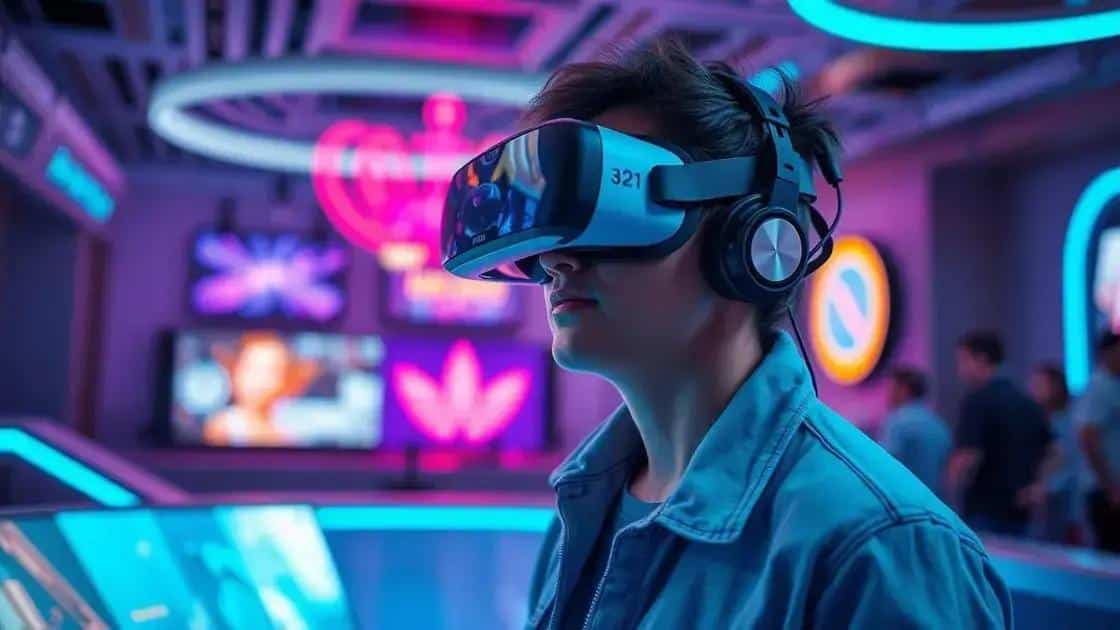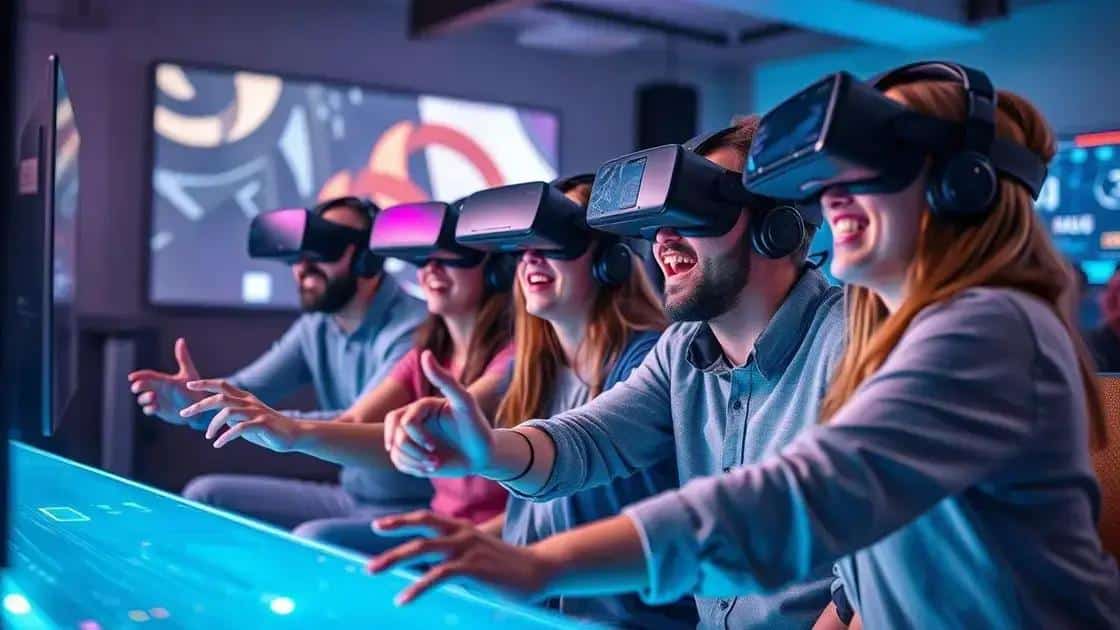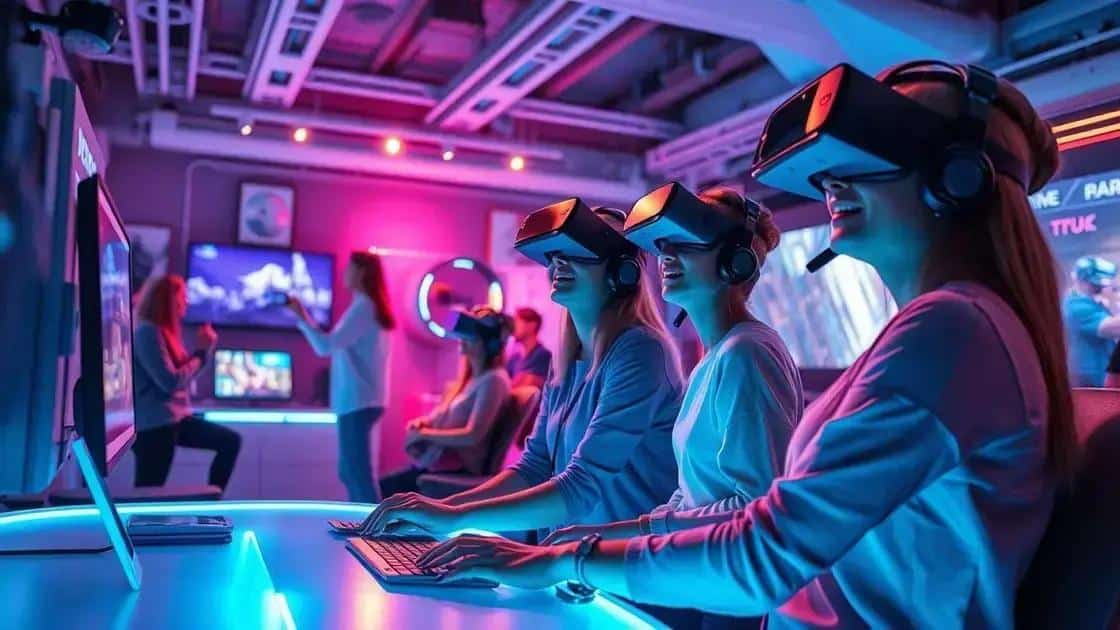VR/AR entertainment industry trends shaping the future

The VR/AR entertainment industry is rapidly evolving, providing immersive experiences that transform gaming, live events, and social interactions, while future trends indicate increased accessibility and enhanced user engagement.
VR/AR entertainment industry trends are reshaping how we consume content. Have you ever wondered how virtual worlds can elevate your gaming or movie experience? Let’s dive into these exciting developments.
Emerging technologies in VR/AR
Emerging technologies in VR/AR are paving new paths in entertainment, blending the digital and physical worlds. These advancements allow users to engage with media like never before. Imagine stepping into a game and interacting with characters as if they’re right there with you. Technology is rapidly evolving, creating a more immersive experience.
Key Technologies Shaping VR/AR
Several technologies are driving the growth of VR/AR. They enhance how we experience virtual environments:
- Motion tracking devices allow users to move freely and interact.
- Haptic feedback technology provides tactile sensations to make experiences more real.
- Artificial intelligence is used to create adaptive interactions.
- Real-time rendering helps in creating lifelike visuals.
Beyond these, cloud computing plays a pivotal role. It enables high-quality graphics without needing powerful hardware at home. Users can dive into experiences without worrying about device limitations. Likewise, advancements in display technology improve how VR/AR looks. Devices become lighter and offer higher resolutions, making for an engaging experience.
As the industry evolves, things like 5G connectivity will further revolutionize VR/AR. This means faster and smoother experiences, minimizing lag. Imagine attending a virtual concert where every beat feels instant, or collaborating on projects that feel almost real. With these technologies, the future appears bright for VR/AR entertainment.
Impact of VR/AR on gaming

The impact of VR/AR on gaming is profound, redefining how players interact with their favorite games. With immersive experiences, gamers can feel like they are part of the action. Imagine wearing a headset and stepping into a world where every sound and movement feels interactive. This change in gaming dynamics creates exciting opportunities for players.
How VR/AR Enhances Gameplay
In many games, VR/AR takes storytelling and engagement to new heights. Players can explore vast landscapes or engage in intense battles as if they were really there.
- Immersive storytelling draws players deeper into the game world.
- Intuitive controls allow for more natural interaction.
- Enhanced visuals create stunning environments for exploration.
- Social interactions in games become more lifelike and meaningful.
Additionally, the introduction of VR/AR technology broadens the possibilities for game developers. They can create unique gameplay mechanics that weren’t possible before. For instance, players can physically move around their space while exploring virtual worlds. This adds a layer of realism that traditional gaming consoles can’t match.
Moreover, multiplayer experiences in VR/AR allow friends to connect like never before. Gamers can meet in shared virtual environments, enhancing collaboration and competition. As these technologies develop, we expect even more exciting innovations that will further transform the gaming landscape. The future of VR/AR gaming promises to be more interactive, more fun, and ever more engaging for players.
How VR/AR is revolutionizing live events
How VR/AR is revolutionizing live events is a fascinating topic, showcasing the transformation in how audiences experience concerts, sports, and other performances. These technologies bring an exciting element to live events, creating unforgettable moments for participants.
Immersive Experiences
At live events, VR/AR enhances the connection between performers and audiences. Attendees can feel as though they are part of the show, even when they are miles away. People can enjoy front-row seats from their homes, with the ability to experience every detail.
- 360-degree views allow fans to feel present on stage with their favorite artists.
- Augmented displays can provide additional information about the event in real time.
- Interactive elements engage the audience beyond typical viewing.
- Multi-user experiences let fans connect and interact during events.
Beyond the audience experience, performers benefit immensely from these technologies. They can reach a broader audience by hosting virtual events. For example, artists can perform live for fans worldwide without the constraints of physical venues. This not only increases their visibility but also transforms how they engage with their fans.
Additionally, sponsors and brands leverage VR/AR to enhance their marketing strategies during live events. They create immersive branding experiences that captivate attendees. Virtual activations can provide unique opportunities for fans to engage with products and experiences at events.
Future predictions for VR/AR entertainment

Future predictions for VR/AR entertainment suggest exciting changes ahead. As technology continues to advance, it’s likely that we will see more innovative experiences that captivate audiences like never before. The possibilities are endless, and this rapidly growing field is opening up new avenues for creativity and interaction.
Trends to Watch
Experts believe several trends will shape the landscape of VR/AR entertainment over the next few years. Developers are focusing on creating more engaging and interactive content that blends seamlessly with reality.
- Increased use of AI in VR/AR can lead to personalized gaming experiences.
- Advancements in hardware will allow more users to access high-quality VR/AR experiences.
- Social integration will enhance multiplayer experiences, making them more communal.
- Content creation tools will empower more people to create their unique VR/AR experiences.
Moreover, as VR/AR becomes more mainstream, we can expect to see it in more traditional forms of entertainment, including movies and live events. Imagine watching a film where you can choose your perspective or interact with the characters. This level of engagement will elevate storytelling in unprecedented ways.
Another significant trend is the growth of virtual reality social platforms. These spaces allow users to meet, interact, and collaborate with others in immersive environments, creating new types of social interactions.
In conclusion, the VR/AR entertainment industry is rapidly evolving. With emerging technologies, we can expect more immersive experiences that will change how we engage with entertainment. From gaming to live events, the potential for innovation seems limitless. As we look to the future, creativity and technology will combine to open up exciting new options for audiences around the world.
FAQ – Frequently Asked Questions About VR/AR Entertainment
What is the impact of VR and AR on live events?
VR and AR create immersive experiences that allow audiences to feel present at live events, even from their homes.
How is VR/AR changing gaming experiences?
VR/AR transforms gaming by offering more interactive and engaging environments where players can physically move and connect with the game.
What are the future trends in VR/AR entertainment?
Future trends include increased accessibility, social integration, and new interactive storytelling techniques to enhance the viewer experience.
Can VR/AR be used for educational purposes?
Yes, VR/AR can provide immersive learning experiences that improve engagement and understanding of complex subjects.






